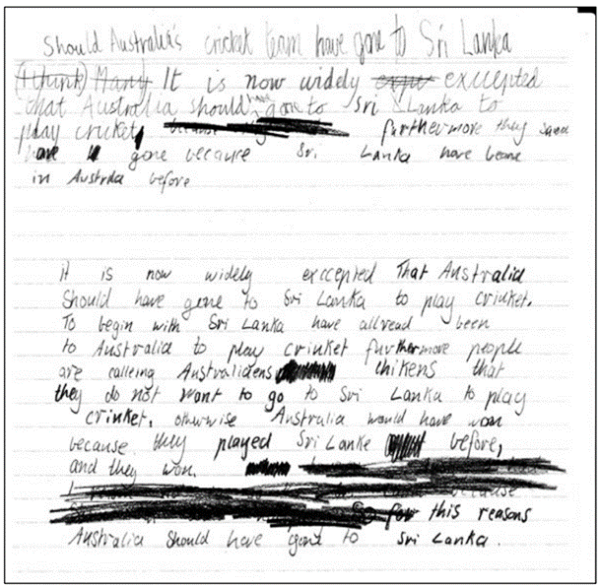Student information
The student is in Year 5. They were born in Poland and speak Polish as their home language. They started school in Foundation in Victoria.
Task
The students read and examined the structural organisation and linguistic features of an exposition. They had jointly constructed an exposition with the teacher before writing their own text on a topic of their choice.
The analysis is based on the student’s writing before correction.

Text
Should Australia’s cricket team have gone to Sri Lanka
(I think)Many It is now widely
expe exccepted that Australia should have gone to Sri
LLanka to play cricket
because [text crossed out] furthermore they saed have
L gone because Sri Lanka have beone in Austrila before
it is now widely exccepted That Australia Should have gone to Sri Lanka to play criuket.
To begin with Sri Lanka have allread been to Australia to play criuket fuvthermore people are calleing Australiaens [text crossed out] chikens that they do not want to go to Sri Lanka to play criuket. othwwise Australia would have won because they played Sri Lanka [text crossed out] before, and they won.
This reasons Australia should have gone to Sri Lanka.
This sample of student work demonstrates that the student can:
- Use the text type appropriate to the task (VCEALL466) *includes a heading using modal verb should
- Use a range of devices to maintain cohesion (VCEALL468) *uses furthermore and otherwise
- Spell most words accurately, drawing on a range of strategies but with some invented spelling still evident (VCEALL477)
- Use a range of sentence structures appropriate to the text, with some errors (VCEALL469)
- Maintain appropriate tense throughout a text (VCEALL470)
- Combine simple sentences using common conjunctions (VCEALL472)
- Create mood and feeling through the selection of appropriate vocabulary and idiom (VCEALL475) *uses the modal verb should to present a point of view
Overall, this student can also:
- Write texts that present a point of view on topics discussed in class (VCEALC456)
Possible next steps for this student's learning
- Using a planning template to organise arguments for and against (VCEALA460) (VCEALA461)
- Elaborating on arguments by including examples and reasons (VCEALA459)
- Working with a partner to give and receive feedback on draft text, including in their home language if possible and appropriate (VCEALA462) (VCEALA464)
- Keeping a personal list of commonly misspelt words in an individual improvement journal, with teacher feedback and support (VCEALL474)
Pathways and transitions considerations
A Year 5 student who is working within the range of B3 in any one language mode is not ready to transition to the English curriculum regardless of their proficiency in the other two language modes. This student will continue on Pathway B of the EAL curriculum in all language modes.
A Year 5 student should consistently demonstrate the final achievement standard in Pathway B (Level B3) in all three language modes before they transition to the English curriculum.
They will need to be equally capable across all three language modes to be able to meet the learning expectations in the English curriculum at the level taught to their mainstream peers, and without substantial language support.
They will need to be sufficiently proficient in understanding and using the academic language across the learning areas to participate in learning activities across the Victorian curriculum.
They will also need to be able to understand and use the academic English of the curriculum in subsequent years without substantial language support, when the cognitive and linguistic demands of the Victorian curriculum increase.
Related pages
Student work samples: Level B3 Speaking and Listening
Student work samples: Level B3 Reading and Viewing
Student work samples: Level B2 Writing